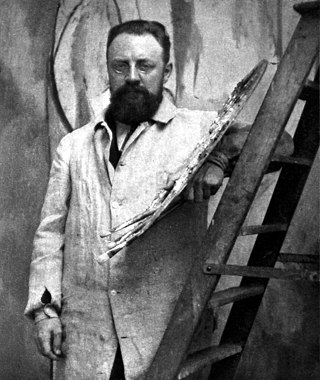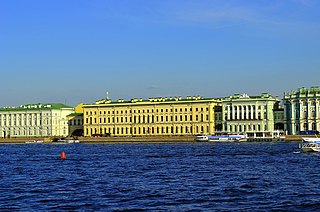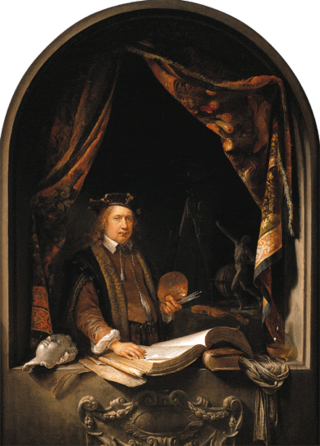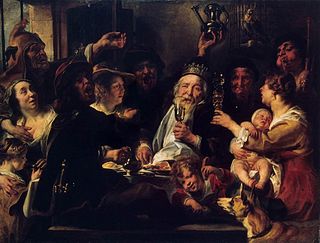
Henri Émile Benoît Matisse was a French visual artist, known for both his use of colour and his fluid and original draughtsmanship. He was a draughtsman, printmaker, and sculptor, but is known primarily as a painter. Matisse is commonly regarded, along with Pablo Picasso, as one of the artists who best helped to define the revolutionary developments in the visual arts throughout the opening decades of the twentieth century, responsible for significant developments in painting and sculpture.

The State Hermitage Museum is a museum of art and culture in Saint Petersburg, Russia. It was founded in 1764 when Empress Catherine the Great acquired a collection of paintings from the Berlin merchant Johann Ernst Gotzkowsky. The museum celebrates the anniversary of its founding each year on 7 December, Saint Catherine's Day. It has been open to the public since 1852. The Art Newspaper ranked the museum 10th in their list of the most visited art museums, with 2,812,913 visitors in 2022.

Gerrit Dou, also known as GerardDouw or Dow, was a Dutch Golden Age painter, whose small, highly polished paintings are typical of the Leiden fijnschilders. He specialised in genre scenes and is noted for his trompe-l'œil "niche" paintings and candlelit night-scenes with strong chiaroscuro. He was a student of Rembrandt.

Jan Davidsz. de Heem or in-full Jan Davidszoon de Heem, also called Johannes de Heem or Johannes van Antwerpen or Jan Davidsz de Hem, was a still life painter who was active in Utrecht and Antwerp. He is a major representative of that genre in both Dutch and Flemish Baroque painting.

David Teniers the Younger or David Teniers II was a Flemish Baroque painter, printmaker, draughtsman, miniaturist painter, staffage painter, copyist and art curator. He was an extremely versatile artist known for his prolific output. He was an innovator in a wide range of genres such as history painting, genre painting, landscape painting, portrait and still life. He is now best remembered as the leading Flemish genre painter of his day. Teniers is particularly known for developing the peasant genre, the tavern scene, pictures of collections and scenes with alchemists and physicians.

The Russian Academy of Arts, informally known as the Saint Petersburg Academy of Arts, was an art academy in Saint Petersburg, founded in 1757 by the founder of the Imperial Moscow University Ivan Shuvalov under the name Academy of the Three Noblest Arts. Catherine the Great renamed it the Imperial Academy of Arts and commissioned a new building, completed 25 years later in 1789 by the Neva River. The academy promoted the neoclassical style and technique, and sent its promising students to European capitals for further study. Training at the academy was virtually required for artists to make successful careers.

Karl Pavlovich Bryullov, also Briullov or Briuloff, born Charles Bruleau was a Russian painter. He is regarded as a key figure in transition from the Russian neoclassicism to romanticism.

George Dawe was an English portraitist who painted 329 portraits of Russian generals active during Napoleon's invasion of Russia for the Military Gallery of the Winter Palace. He relocated to Saint Petersburg in 1819, where he won acclaim for his work from the artistic establishment and complimentary verses by Pushkin. He was the son of Philip Dawe, a successful mezzotint engraver who also produced political cartoons relating to the events of the Boston Tea Party. One of his brothers was Henry Edward Dawe, also a portraitist. He died on 15 October 1829 in Kentish Town, United Kingdom.

David Ryckaert III, David Rijckaert III or David Rijckaert the Younger was a Flemish painter known for his contribution to genre painting, in particular through his scenes of merry companies and peasants. He also painted hell scenes and images of alchemists. He enjoyed the patronage of prominent patrons and was a painter to the court of the governor of the Southern Netherlands.

Gillis van Tilborgh or Gillis van Tilborch (c. 1625 – c. 1678) was a Flemish painter who worked in various genres including portraits, 'low-life' and elegant genre paintings and paintings of picture galleries. He became the keeper of the picture collection of the governor of the Habsburg Netherlands and travelled in England where he painted group portraits.

Nikolai Dmitrievich Dmitriev-Orenburgsky or Nikolaj Dmitrievič Dmitriev-Orenburgskij was a battle and genre painter from the Russian Empire who added to his surname, to distinguish him from other artists Dmitrievs, epithet: Orenburgsky. He spent 1875–1885 living and working in Paris.

Martin Ferdinand Quadal was a Moravian-Austrian painter and engraver. Quadal is a representative of the Austrian school of painting, working all across Europe in England, Italy, Austria, Holland, Germany, France, and Russia.
Valentina Vasilievna Monakhova is a Soviet Russian painter, watercolorist, graphic artist, and art teacher, living and working in Saint Petersburg regarded as one of representatives of the Leningrad school of painting.
Kapitolina Alexeevna Rumiantseva was a Russian Soviet realist painter and graphic artist, who lived and worked in Saint Petersburg. She was a member of the Saint Petersburg Union of Artists, regarded as one of representatives of the Leningrad school of painting, most famous for her still life paintings.

Étienne Jeaurat was a French painter, above all remembered for his lively street scenes.

Flora or Saskia as Flora is a 1634 oil-on-canvas painting by Rembrandt, depicting his wife Saskia van Uylenburgh as the goddess Flora. It is held by the Hermitage Museum in St. Petersburg.

Abraham Teniers was a Flemish painter and engraver who specialized in genre paintings of villages, inns and monkey scenes. He was a member of artist family Teniers which came to prominence in the 17th century. He was also active as a publisher.

The King Drinks or The Bean King is a c.1638 painting by the Flemish Baroque artist Jacob Jordaens, now in the Hermitage Museum in St Petersburg.

The Oude Voetboog Guild in the Grote Markt is a 1643 oil-on-canvas painting by David Teniers the Younger, in the collection of the Hermitage Museum, in Saint Petersburg. It is signed and dated bottom left "DAVID. TENIERS. FEC. A 1643".


















